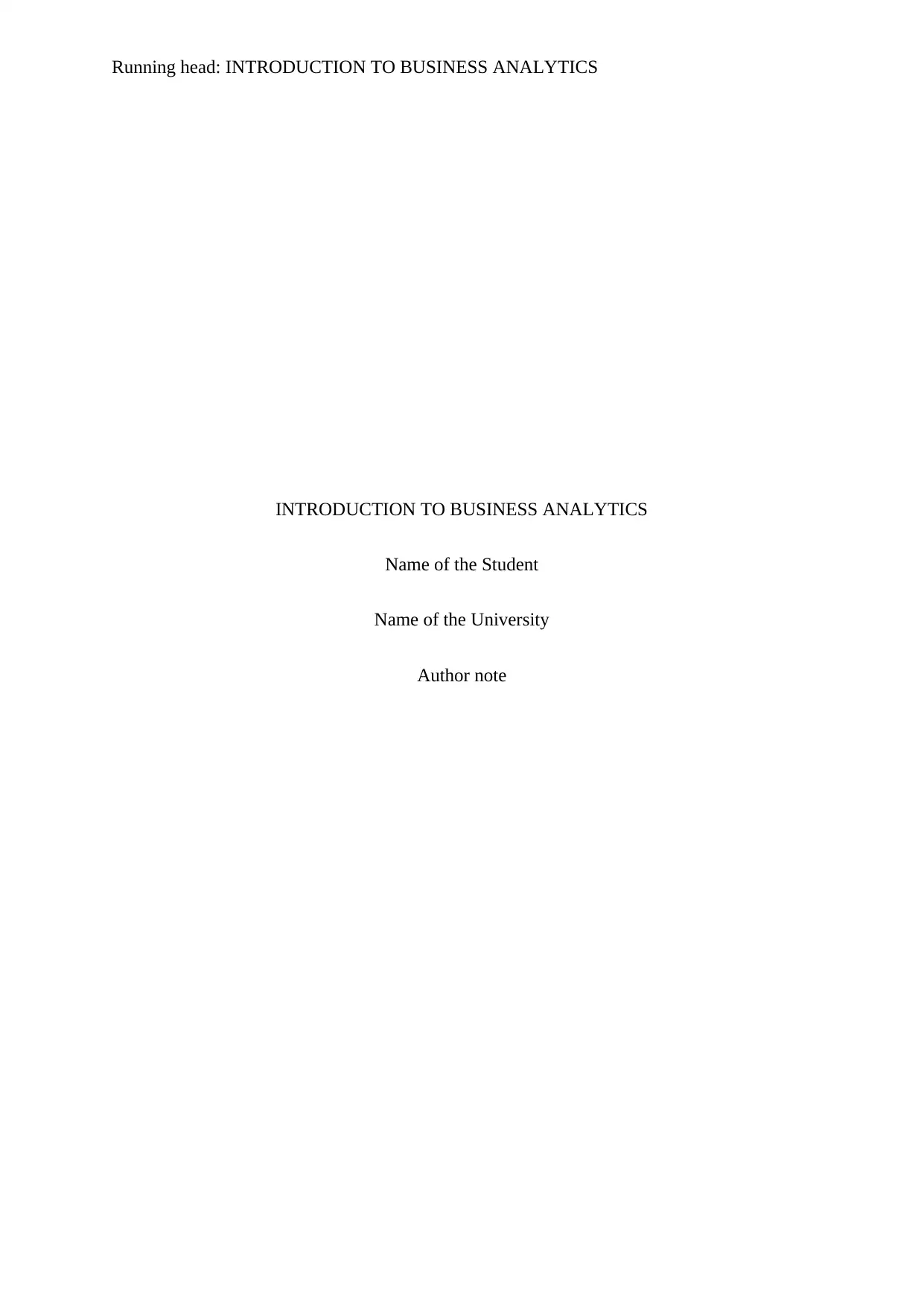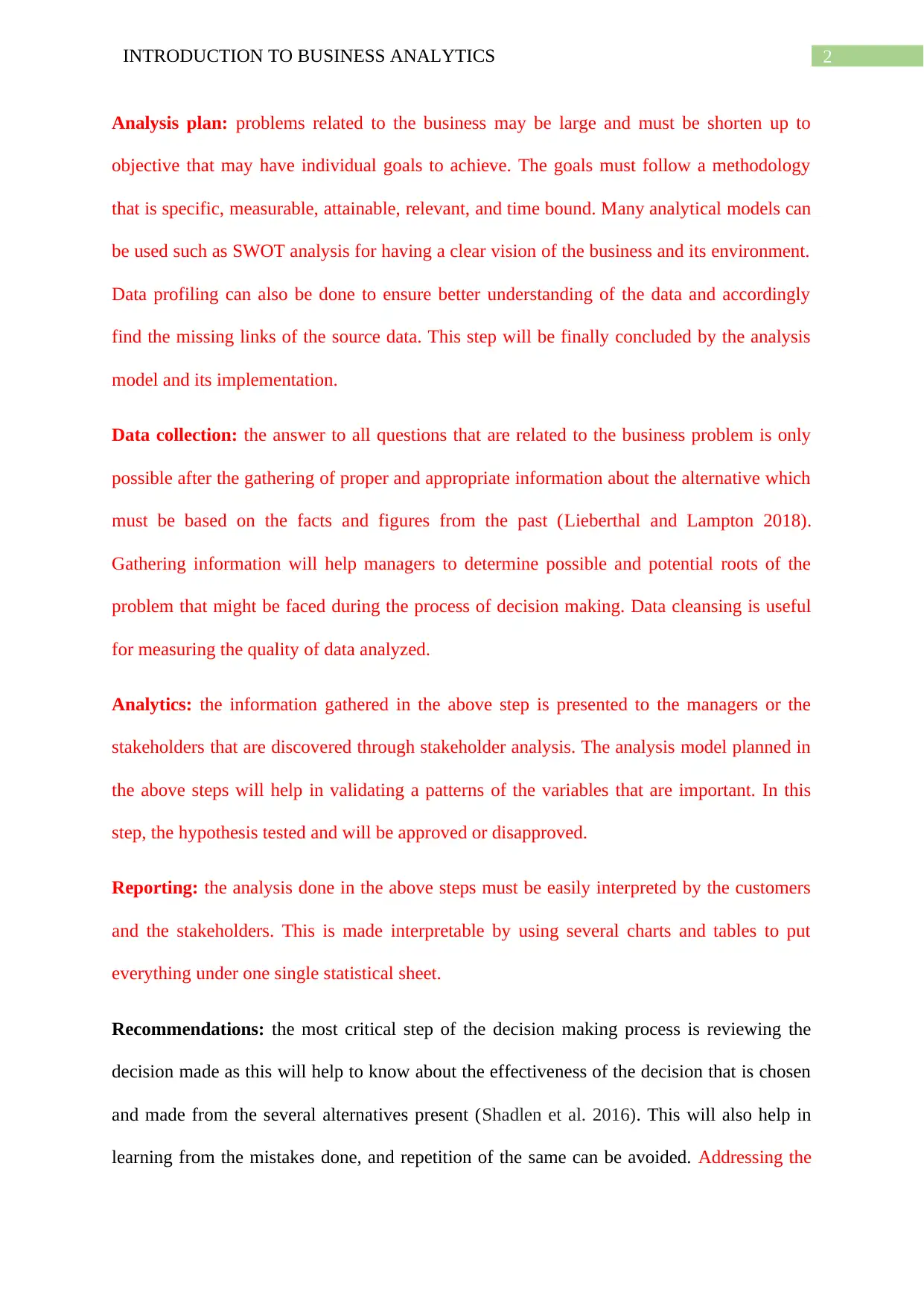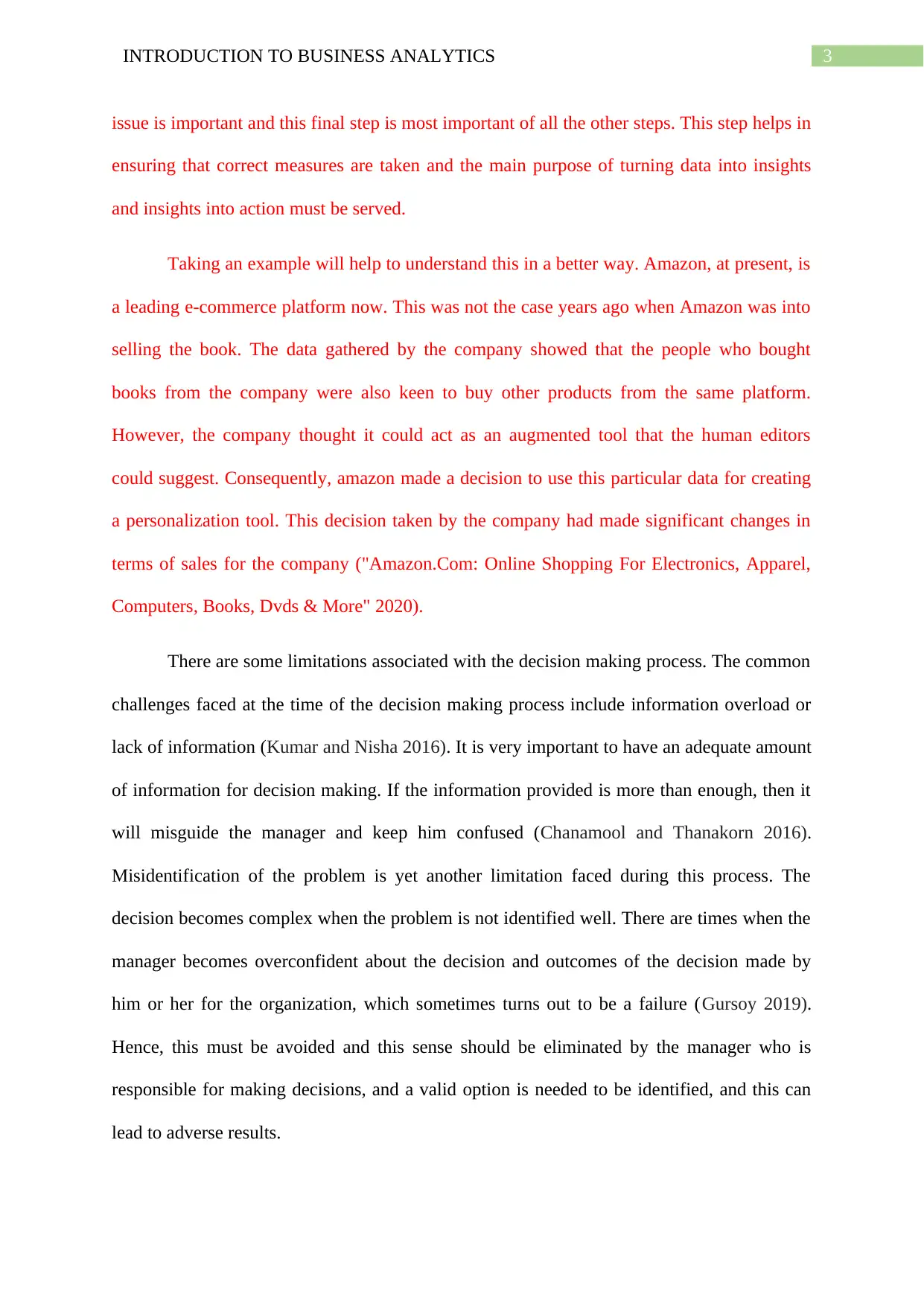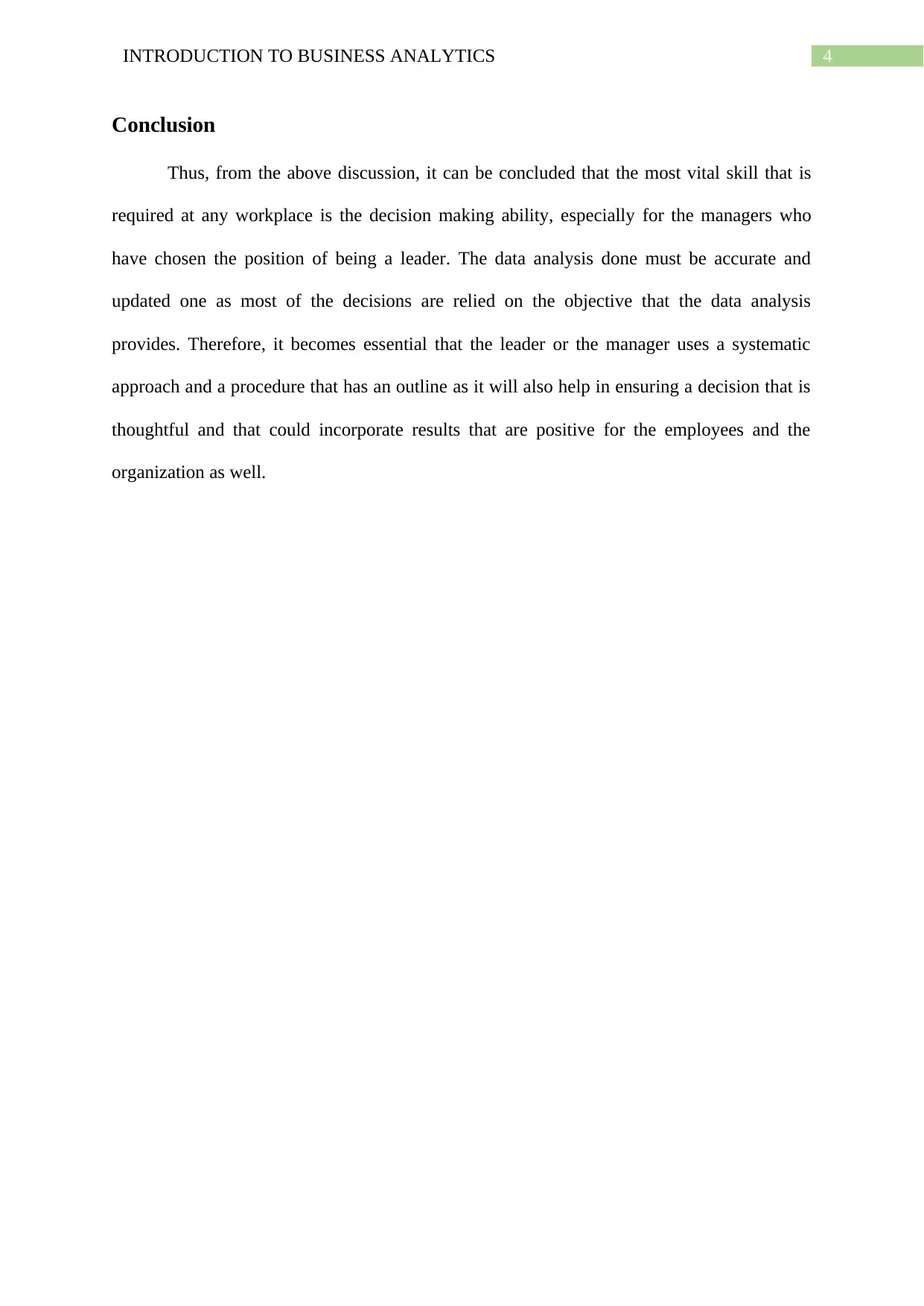Business Analytics: Decision Making Process and Stages Analysis
VerifiedAdded on 2022/09/15
|7
|1486
|24
Essay
AI Summary
This essay provides a comprehensive overview of the business decision-making process, emphasizing the significance of each stage. The introduction highlights the importance of informed decisions for business success, and the body delves into the seven essential steps of the data-to-decision framework. These stages include defining the problem, creating an analysis plan, data collection and cleansing, analytics, reporting, and making recommendations. The essay uses Amazon as a practical example to illustrate how data analysis and strategic decision-making can drive business growth. It also addresses the limitations of the decision-making process, such as information overload and misidentification of problems. The conclusion stresses the critical role of decision-making skills, especially for managers, and the importance of a systematic approach based on accurate data analysis to achieve positive outcomes for the organization and its employees.

Running head: INTRODUCTION TO BUSINESS ANALYTICS
INTRODUCTION TO BUSINESS ANALYTICS
Name of the Student
Name of the University
Author note
INTRODUCTION TO BUSINESS ANALYTICS
Name of the Student
Name of the University
Author note
Paraphrase This Document
Need a fresh take? Get an instant paraphrase of this document with our AI Paraphraser

1INTRODUCTION TO BUSINESS ANALYTICS
Introduction
In business, decisions are made on a regular basis and for every step. When a choice
is made out of the several alternatives present, this is known as business decision making.
The decision made will help the business in improving the performance and be useful in the
market. Decision making is only possible if the number of alternatives present is two or more
(Ayyub 2014). Based on the decision made, several action plans are developed for the
business operating.
This essay discusses about the several stages of business decision making, their role
and importance, and how each stage is integral for the overall outcome.
Body
The process of decision making helps the professionals in solving the problems
through a systematic approach by observing all the alternatives present and then finally
choosing the best alternative suited for the problem (Ayyub 2014). The decision that is
informed and is thoughtful has a positive impact on the goals and objectives of the
organization.
The process of business decision making is based on seven essential steps or stages
that is a data to decision framework. Having a proper information and knowledge of all these
stages will help the manager to make decisions that are clear and effective for the
organization (Lieberthal and Lampton 2018).
Defining a problem: it is vital to recognize the problem to be solved and then address it.
Besides, there must be a determination as to what difference this decision can make on the
employees as well as the customers of the business.
Introduction
In business, decisions are made on a regular basis and for every step. When a choice
is made out of the several alternatives present, this is known as business decision making.
The decision made will help the business in improving the performance and be useful in the
market. Decision making is only possible if the number of alternatives present is two or more
(Ayyub 2014). Based on the decision made, several action plans are developed for the
business operating.
This essay discusses about the several stages of business decision making, their role
and importance, and how each stage is integral for the overall outcome.
Body
The process of decision making helps the professionals in solving the problems
through a systematic approach by observing all the alternatives present and then finally
choosing the best alternative suited for the problem (Ayyub 2014). The decision that is
informed and is thoughtful has a positive impact on the goals and objectives of the
organization.
The process of business decision making is based on seven essential steps or stages
that is a data to decision framework. Having a proper information and knowledge of all these
stages will help the manager to make decisions that are clear and effective for the
organization (Lieberthal and Lampton 2018).
Defining a problem: it is vital to recognize the problem to be solved and then address it.
Besides, there must be a determination as to what difference this decision can make on the
employees as well as the customers of the business.

2INTRODUCTION TO BUSINESS ANALYTICS
Analysis plan: problems related to the business may be large and must be shorten up to
objective that may have individual goals to achieve. The goals must follow a methodology
that is specific, measurable, attainable, relevant, and time bound. Many analytical models can
be used such as SWOT analysis for having a clear vision of the business and its environment.
Data profiling can also be done to ensure better understanding of the data and accordingly
find the missing links of the source data. This step will be finally concluded by the analysis
model and its implementation.
Data collection: the answer to all questions that are related to the business problem is only
possible after the gathering of proper and appropriate information about the alternative which
must be based on the facts and figures from the past (Lieberthal and Lampton 2018).
Gathering information will help managers to determine possible and potential roots of the
problem that might be faced during the process of decision making. Data cleansing is useful
for measuring the quality of data analyzed.
Analytics: the information gathered in the above step is presented to the managers or the
stakeholders that are discovered through stakeholder analysis. The analysis model planned in
the above steps will help in validating a patterns of the variables that are important. In this
step, the hypothesis tested and will be approved or disapproved.
Reporting: the analysis done in the above steps must be easily interpreted by the customers
and the stakeholders. This is made interpretable by using several charts and tables to put
everything under one single statistical sheet.
Recommendations: the most critical step of the decision making process is reviewing the
decision made as this will help to know about the effectiveness of the decision that is chosen
and made from the several alternatives present (Shadlen et al. 2016). This will also help in
learning from the mistakes done, and repetition of the same can be avoided. Addressing the
Analysis plan: problems related to the business may be large and must be shorten up to
objective that may have individual goals to achieve. The goals must follow a methodology
that is specific, measurable, attainable, relevant, and time bound. Many analytical models can
be used such as SWOT analysis for having a clear vision of the business and its environment.
Data profiling can also be done to ensure better understanding of the data and accordingly
find the missing links of the source data. This step will be finally concluded by the analysis
model and its implementation.
Data collection: the answer to all questions that are related to the business problem is only
possible after the gathering of proper and appropriate information about the alternative which
must be based on the facts and figures from the past (Lieberthal and Lampton 2018).
Gathering information will help managers to determine possible and potential roots of the
problem that might be faced during the process of decision making. Data cleansing is useful
for measuring the quality of data analyzed.
Analytics: the information gathered in the above step is presented to the managers or the
stakeholders that are discovered through stakeholder analysis. The analysis model planned in
the above steps will help in validating a patterns of the variables that are important. In this
step, the hypothesis tested and will be approved or disapproved.
Reporting: the analysis done in the above steps must be easily interpreted by the customers
and the stakeholders. This is made interpretable by using several charts and tables to put
everything under one single statistical sheet.
Recommendations: the most critical step of the decision making process is reviewing the
decision made as this will help to know about the effectiveness of the decision that is chosen
and made from the several alternatives present (Shadlen et al. 2016). This will also help in
learning from the mistakes done, and repetition of the same can be avoided. Addressing the
⊘ This is a preview!⊘
Do you want full access?
Subscribe today to unlock all pages.

Trusted by 1+ million students worldwide

3INTRODUCTION TO BUSINESS ANALYTICS
issue is important and this final step is most important of all the other steps. This step helps in
ensuring that correct measures are taken and the main purpose of turning data into insights
and insights into action must be served.
Taking an example will help to understand this in a better way. Amazon, at present, is
a leading e-commerce platform now. This was not the case years ago when Amazon was into
selling the book. The data gathered by the company showed that the people who bought
books from the company were also keen to buy other products from the same platform.
However, the company thought it could act as an augmented tool that the human editors
could suggest. Consequently, amazon made a decision to use this particular data for creating
a personalization tool. This decision taken by the company had made significant changes in
terms of sales for the company ("Amazon.Com: Online Shopping For Electronics, Apparel,
Computers, Books, Dvds & More" 2020).
There are some limitations associated with the decision making process. The common
challenges faced at the time of the decision making process include information overload or
lack of information (Kumar and Nisha 2016). It is very important to have an adequate amount
of information for decision making. If the information provided is more than enough, then it
will misguide the manager and keep him confused (Chanamool and Thanakorn 2016).
Misidentification of the problem is yet another limitation faced during this process. The
decision becomes complex when the problem is not identified well. There are times when the
manager becomes overconfident about the decision and outcomes of the decision made by
him or her for the organization, which sometimes turns out to be a failure (Gursoy 2019).
Hence, this must be avoided and this sense should be eliminated by the manager who is
responsible for making decisions, and a valid option is needed to be identified, and this can
lead to adverse results.
issue is important and this final step is most important of all the other steps. This step helps in
ensuring that correct measures are taken and the main purpose of turning data into insights
and insights into action must be served.
Taking an example will help to understand this in a better way. Amazon, at present, is
a leading e-commerce platform now. This was not the case years ago when Amazon was into
selling the book. The data gathered by the company showed that the people who bought
books from the company were also keen to buy other products from the same platform.
However, the company thought it could act as an augmented tool that the human editors
could suggest. Consequently, amazon made a decision to use this particular data for creating
a personalization tool. This decision taken by the company had made significant changes in
terms of sales for the company ("Amazon.Com: Online Shopping For Electronics, Apparel,
Computers, Books, Dvds & More" 2020).
There are some limitations associated with the decision making process. The common
challenges faced at the time of the decision making process include information overload or
lack of information (Kumar and Nisha 2016). It is very important to have an adequate amount
of information for decision making. If the information provided is more than enough, then it
will misguide the manager and keep him confused (Chanamool and Thanakorn 2016).
Misidentification of the problem is yet another limitation faced during this process. The
decision becomes complex when the problem is not identified well. There are times when the
manager becomes overconfident about the decision and outcomes of the decision made by
him or her for the organization, which sometimes turns out to be a failure (Gursoy 2019).
Hence, this must be avoided and this sense should be eliminated by the manager who is
responsible for making decisions, and a valid option is needed to be identified, and this can
lead to adverse results.
Paraphrase This Document
Need a fresh take? Get an instant paraphrase of this document with our AI Paraphraser

4INTRODUCTION TO BUSINESS ANALYTICS
Conclusion
Thus, from the above discussion, it can be concluded that the most vital skill that is
required at any workplace is the decision making ability, especially for the managers who
have chosen the position of being a leader. The data analysis done must be accurate and
updated one as most of the decisions are relied on the objective that the data analysis
provides. Therefore, it becomes essential that the leader or the manager uses a systematic
approach and a procedure that has an outline as it will also help in ensuring a decision that is
thoughtful and that could incorporate results that are positive for the employees and the
organization as well.
Conclusion
Thus, from the above discussion, it can be concluded that the most vital skill that is
required at any workplace is the decision making ability, especially for the managers who
have chosen the position of being a leader. The data analysis done must be accurate and
updated one as most of the decisions are relied on the objective that the data analysis
provides. Therefore, it becomes essential that the leader or the manager uses a systematic
approach and a procedure that has an outline as it will also help in ensuring a decision that is
thoughtful and that could incorporate results that are positive for the employees and the
organization as well.

5INTRODUCTION TO BUSINESS ANALYTICS
References
"Amazon.Com: Online Shopping For Electronics, Apparel, Computers, Books, Dvds &
More". 2020. Amazon.Com. https://www.amazon.com/.
Ayyub, Bilal M. "Systems resilience for multihazard environments: Definition, metrics, and
valuation for decision making." Risk analysis 34, no. 2 (2014): 340-355.
Chanamool, Nalinee, and Thanakorn Naenna. "Fuzzy FMEA application to improve
decision-making process in an emergency department." Applied Soft Computing 43 (2016):
441-453.
Gursoy, Dogan. "A critical review of determinants of information search behavior and
utilization of online reviews in decision making process (invited paper for ‘luminaries’
special issue of International Journal of Hospitality Management)." International Journal of
Hospitality Management 76 (2019): 53-60.
Kumar, Satish, and Nisha Goyal. "Evidence on rationality and behavioural biases in
investment decision making." Qualitative Research in Financial Markets (2016).
Lieberthal, Kenneth G., and David M. Lampton, eds. Bureaucracy, politics, and decision
making in post-Mao China. Vol. 14. University of California Press, 2018.
Morente-Molinera, Juan Antonio, Gang Kou, Rubén González-Crespo, Juan M. Corchado,
and Enrique Herrera-Viedma. "Solving multi-criteria group decision making problems under
environments with a high number of alternatives using fuzzy ontologies and multi-granular
linguistic modelling methods." Knowledge-Based Systems 137 (2017): 54-64.
Shadlen, Michael N., Roozbeh Kiani, William T. Newsome, Joshua I. Gold, Daniel M.
Wolpert, Ariel Zylberberg, Jochen Ditterich, Victor De Lafuente, Tianming Yang, and Jamie
References
"Amazon.Com: Online Shopping For Electronics, Apparel, Computers, Books, Dvds &
More". 2020. Amazon.Com. https://www.amazon.com/.
Ayyub, Bilal M. "Systems resilience for multihazard environments: Definition, metrics, and
valuation for decision making." Risk analysis 34, no. 2 (2014): 340-355.
Chanamool, Nalinee, and Thanakorn Naenna. "Fuzzy FMEA application to improve
decision-making process in an emergency department." Applied Soft Computing 43 (2016):
441-453.
Gursoy, Dogan. "A critical review of determinants of information search behavior and
utilization of online reviews in decision making process (invited paper for ‘luminaries’
special issue of International Journal of Hospitality Management)." International Journal of
Hospitality Management 76 (2019): 53-60.
Kumar, Satish, and Nisha Goyal. "Evidence on rationality and behavioural biases in
investment decision making." Qualitative Research in Financial Markets (2016).
Lieberthal, Kenneth G., and David M. Lampton, eds. Bureaucracy, politics, and decision
making in post-Mao China. Vol. 14. University of California Press, 2018.
Morente-Molinera, Juan Antonio, Gang Kou, Rubén González-Crespo, Juan M. Corchado,
and Enrique Herrera-Viedma. "Solving multi-criteria group decision making problems under
environments with a high number of alternatives using fuzzy ontologies and multi-granular
linguistic modelling methods." Knowledge-Based Systems 137 (2017): 54-64.
Shadlen, Michael N., Roozbeh Kiani, William T. Newsome, Joshua I. Gold, Daniel M.
Wolpert, Ariel Zylberberg, Jochen Ditterich, Victor De Lafuente, Tianming Yang, and Jamie
⊘ This is a preview!⊘
Do you want full access?
Subscribe today to unlock all pages.

Trusted by 1+ million students worldwide

6INTRODUCTION TO BUSINESS ANALYTICS
Roitman. "Comment on “Single-trial spike trains in parietal cortex reveal discrete steps
during decision-making”." Science 351, no. 6280 (2016): 1406-1406.
Roitman. "Comment on “Single-trial spike trains in parietal cortex reveal discrete steps
during decision-making”." Science 351, no. 6280 (2016): 1406-1406.
1 out of 7
Related Documents
Your All-in-One AI-Powered Toolkit for Academic Success.
+13062052269
info@desklib.com
Available 24*7 on WhatsApp / Email
![[object Object]](/_next/static/media/star-bottom.7253800d.svg)
Unlock your academic potential
Copyright © 2020–2025 A2Z Services. All Rights Reserved. Developed and managed by ZUCOL.





